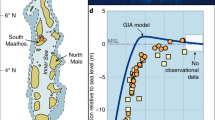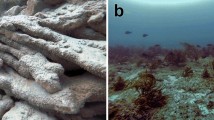Abstract
Rapid sea-level changes during the last interglacial highstand have been inferred from distinct stratigraphic units, which suggest multiple episodes of reef growth1. However, it is difficult to resolve the age differences between fossil reef units2,3,4,5, and results from conventional U–Th geochronology instead suggest a prolonged, stable sea-level highstand during the last interglacial6,7,8. Here we present U–Th ages from last interglacial coral reef sequences in the Bahamas that reflect the timing of sea-level highstands. We use a method that corrects the ages for diagenetic disturbance of the U–Th isotope ratios. Our dated Bahamas stratigraphy confirms that at least one sea-level oscillation interrupted the last interglacial highstand. Further oscillations, as suggested by reconstructions from the Red Sea9, would also be consistent with our data. We estimate that the minimum rate of sea-level change across the first oscillation was 2.6 m per 1,000 years, slightly lower than previous estimates9,10. In contrast, during the past 6,000 years of the Holocene interglacial, sea level was relatively stable11. We therefore suggest that ice sheets during the last interglacial, which was warmer than today and has been proposed as an analogue for future warming12,13, were less stable than during the mid-to-late Holocene.
This is a preview of subscription content, access via your institution
Access options
Subscribe to this journal
Receive 12 print issues and online access
$259.00 per year
only $21.58 per issue
Buy this article
- Purchase on Springer Link
- Instant access to full article PDF
Prices may be subject to local taxes which are calculated during checkout





Similar content being viewed by others
References
Hearty, P. J., Hollin, J. T., Neumann, A. C., O’Leary, M. J. & McCulloch, M. T. Global sea-level fluctuations during the Last Interglaciation (MIS 5e). Quat. Sci. Rev. 26, 2090–2112 (2007).
Thompson, W. G., Spiegelman, M. W., Goldstein, S. L. & Speed, R. C. An open-system model for the U-series age determinations of fossil corals. Earth Planet. Sci. Lett. 210, 365–381 (2003).
Stirling, C. & Andersen, M. Uranium-series dating of fossil coral reefs: Extending the sea-level record beyond the last glacial cycle. Earth Planet. Sci. Lett. 284, 269–283 (2009).
Andersen, M. B., Gallup, C. D., Scholz, D., Stirling, C. H. & Thompson, W. G. U-series dating of fossil coral reefs: Consensus and controversy. PAGES News 17, 54–56 (2009).
Edwards, R. L., Gallup, C. D. & Cheng, H. in Uranium-Series Geochemistry (eds Bourdon, B., Henderson, G. M., Lundstrom, C. C. & Turner, S. P.) 363–405 (Mineralogical Society of America, 2003).
Gallup, C. D., Edwards, R. L. & Johnson, R. G. The timing of high sea levels over the past 200,000 years. Science 263, 796–800 (1994).
Stirling, C., Esat, T., Lambeck, K. & McCulloch, M. Timing and duration of the Last Interglacial: Evidence for a restricted interval of widespread coral reef growth. Earth Planet. Sci. Lett. 160, 745–762 (1998).
Stirling, C., Esat, T., McCulloch, M. & Lambeck, K. High-precision U-series dating of corals from Western Australia and implications for the timing and duration of the Last Interglacial. Earth Planet. Sci. Lett. 135, 115–130 (1995).
Rohling, E. J. et al. High rates of sea-level rise during the last interglacial period. Nature Geosci. 1, 38–42 (2008).
Blanchon, P., Eisenhauer, A., Fietzke, J. & Liebetrau, V. Rapid sea-level rise and reef back-stepping at the close of the last interglacial highstand. Nature 458, 881–885 (2009).
Peltier, W. R. & Fairbanks, R. G. Global glacial ice volume and the Last Glacial Maximum duration from an extended Barbados sea level record. Quat. Sci. Rev. 25, 3322–3337 (2006).
Clark, P. U. & Huybers, P. Last interglacial and future sea level. Nature 462, 856–857 (2009).
Otto-Bliesner, B. et al. Simulating Arctic climate warmth and icefield retreat in the last interglaciation. Science 311, 1751–1753 (2006).
Chen, J., Curran, H., White, B. & Wasserburg, G. Precise chronology of the last interglacial period: 234U–230Th data from fossil coral reefs in the Bahamas. Geol. Soc. Am. Bull. 103, 82–97 (1991).
Fruijtier, C., Elliott, T. & Schlager, W. Mass-spectrometric 234U–230Th ages from the Key Largo Formation, Florida Keys, United States: Constraints on diagenetic age disturbance. Geol. Soc. Am. Bull. 112, 267–277 (2000).
White, B., Curran, H. A. & Wilson, M. A. Bahamian coral reefs yield evidence of a brief sea-level lowstand during the Last Interglacial. Carbonate. Evaporite. 13, 10–22 (1998).
Edwards, R. L., Chen, J. H. & Wasserburg, G. J. 238U–234U–230Th–232Th systematics and the precise measurement of time over the past 500,000 years. Earth Planet. Sci. Lett. 81, 175–192 (1986).
Bard, E. et al. Deglacial sea-level record from Tahiti corals and the timing of global meltwater discharge. Nature 382, 241–244 (1996).
Bard, E., Hamelin, B. & Fairbanks, R. G. U–Th ages obtained by mass spectrometry in corals from Barbados: Sea level during the past 130,000 years. Nature 346, 456–458 (1990).
Thompson, W. G. & Goldstein, S. L. Open-system coral ages reveal persistent suborbital sea-level cycles. Science 308, 401–404 (2005).
Thompson, W. G. & Goldstein, S. L. A radiometric calibration of the SPECMAP timescale. Quat. Sci. Rev. 25, 3207–3215 (2006).
Scholz, D., Mangini, A. & Meischner, D. in The Climate of Past Interglacials Vol. 7 (eds Sirocko, F., Claussen, M., Sanchez Goni, M. F. & Litt, T.) 119–139 (Developments in Quaternary Sciences, Elsevier, 2007).
Scholz, D., Mangini, A. & Felis, T. U-series dating of diagenetically altered fossil reef corals. Earth Planet. Sci. Lett. 218, 163–178 (2004).
Carew, J. L. & Mylroie, J. E. Quaternary tectonic stability of the Bahamas archipelago: Evidence from fossil coral reefs and flank margin caves. Quat. Sci. Rev. 14, 145–153 (1995).
Pindell, J. L. Alleghenian reconstruction and subsequent evolution of the Gulf of Mexico, Bahamas, and proto-Caribbean. Tectonics 4, 1–39 (1985).
Potter, E-K. & Lambeck, K. Reconciliation of sea-level observations in the Western North Atlantic during the last glacial cycle. Earth Planet. Sci. Lett. 217, 171–181 (2004).
Curran, H. A. & White, B. in Pleistocene and Holocene Carbonate Environments on San Salvador Island, Bahamas (ed. Curran, H. A.) 27–34 (28th International Geological Congress, AGU, Field Trip Guidebook T175, 1989).
Wilson, M. A., Curran, H. A. & White, B. Paleontological evidence of a brief global sea-level event during the last interglacial. Lethaia 31, 241–250 (1998).
IPCC Climate Change 2007: The Physical Science Basis (eds Solomon S. et al.) (Cambridge Univ. Press, 2007).
Acknowledgements
This work was supported by the Woods Hole Oceanographic Institution Ocean and Climate Change Center, the Comer Science and Education Foundation, and NSF awards OCE-0602383, EAR0819714, and OCE0902849. We acknowledge the use of the WHOI ICP-MS Facility and thank S. Birdwhistell and J. Blusztajn for their assistance. E. Griffin and A. Steward of The College of Wooster assisted with Great Inagua fieldwork. S. Hale and R. Herrman of Smith College assisted with San Salvador fieldwork. This is a contribution to the PALSEA working group. We thank the Director and staff of the Gerace Research Centre on San Salvador for logistical support of our fieldwork in the Bahamas. We thank A. Dutton, C. D. Gallup and C. Stirling for their careful reviews, which improved the manuscript.
Author information
Authors and Affiliations
Contributions
W.G.T. provided the geochronology, including mass spectrometry and age interpretations, and wrote the manuscript. H.A.C., B.W. and M.A.W. contributed detailed mapping and stratigraphic interpretations. W.G.T., H.A.C. and M.A.W. participated in the fieldwork and sampling of the Great Inagua and San Salvador field sites.
Corresponding author
Ethics declarations
Competing interests
The authors declare no competing financial interests.
Supplementary information
Supplementary Information
Supplementary Information (PDF 769 kb)
Rights and permissions
About this article
Cite this article
Thompson, W., Allen Curran, H., Wilson, M. et al. Sea-level oscillations during the last interglacial highstand recorded by Bahamas corals. Nature Geosci 4, 684–687 (2011). https://doi.org/10.1038/ngeo1253
Received:
Accepted:
Published:
Issue Date:
DOI: https://doi.org/10.1038/ngeo1253
This article is cited by
-
Enhanced subglacial discharge from Antarctica during meltwater pulse 1A
Nature Communications (2023)
-
Multiple episodes of ice loss from the Wilkes Subglacial Basin during the Last Interglacial
Nature Communications (2023)
-
Asynchronous Antarctic and Greenland ice-volume contributions to the last interglacial sea-level highstand
Nature Communications (2019)
-
The Misery Point cliff, Mayaguana Island, SE Bahamas: a unique record of sea-level highstands since the Early Pleistocene
Swiss Journal of Geosciences (2019)
-
Lack of evidence for a substantial sea-level fluctuation within the Last Interglacial
Nature Geoscience (2018)



